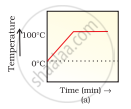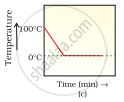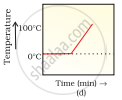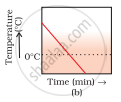Advertisements
Online Mock Tests
Chapters
2: Is Matter Around Us Pure
3: Atoms and Molecules
4: Structure of the Atom
5: The Fundamental Unit of Life
6: Tissues
7: Diversity In Living Organisms
8: Motion
9: Force and Laws of Motion
10: Gravitation
11: Work and Energy
12: Sound
13: Why Do We Fall Ill
14: Natural Resources
15: Improvement In Food Resources
![NCERT Exemplar solutions for Science [English] Class 9 chapter 1 - Matter In Our Surroundings NCERT Exemplar solutions for Science [English] Class 9 chapter 1 - Matter In Our Surroundings - Shaalaa.com](/images/science-english-class-9_6:5f2b1b2038084cf381bfa42c826a928c.jpg)
Advertisements
Solutions for Chapter 1: Matter In Our Surroundings
Below listed, you can find solutions for Chapter 1 of CBSE NCERT Exemplar for Science [English] Class 9.
NCERT Exemplar solutions for Science [English] Class 9 1 Matter In Our Surroundings Multiple Choice Questions [Pages 7 - 1]
Which one of the following set of phenomena would increase on raising the temperature ?
diffusion, evaporation, compression of gases
evaporation, compression of gases, solubility
evaporation, diffusion, expansion of gases
evaporation, solubility, diffusion, compression of gases
Seema visited a Natural Gas Compressing Unit and found that the gas can be liquefied under specific conditions of temperature and pressure. While sharing her experience with friends she got confused. Help her to identify the correct set of conditions
Low temperature, low pressure
High temperature, low pressure
Low temperature, high pressure
High temperature, high pressure
The property to flow is unique to fluids. Which one of the following statements is correct?
Only gases behave like fluids
Gases and solids behave like fluids
Gases and liquids behave like fluids
Only liquids are fluids
During summer, water kept in an earthen pot becomes cool because of the phenomenon of
diffusion
transpiration
osmosis
evaporation
A few substances are arranged in the increasing order of 'forces of attraction' between their particles. Which one of the following represents the correct arrangement?
water, air, wind
air, sugar, oil
oxygen, water, sugar
salt, juice, air
On converting 25°C, 38°C and 66°C to Kelvin scale, the correct sequence of temperatures will be :
298 K, 311 K and 339 K
298 K, 300 K and 338 K
273 K, 278 K and 543 K
298 K, 310 K and 338 K
Choose the correct statement of the following
conversion of solid into vapours without passing through the liquid state is called sublimation.
conversion of vapours into solid without passing through the liquid state is called vapourisation.
conversion of vapours into solid without passing through the liquid state is called freezing.
conversion of solid into liquid is called sublimation.
The boiling points of diethyl ether, acetone and n-butyl alcohol are 35°C, 56°C and 118°C respectively. Which one of the following correctly represents their boiling points in kelvin scale?
306 K, 329 K, 391 K
308 K, 329 K, 392 K
308 K, 329 K, 391 K
329 K, 392 K, 308 K
Which condition out of the following will increase the evaporation of water?
Increase in temperature of water
Decrease in temperature of water
Less exposed surface area of water
Adding common salt to water
In which of the following conditions, the distance between the molecules of hydrogen gas would increase?
- increasing pressure on hydrogen contained in a closed container
- some hydrogen gas leaking out of the container
- increasing the volume of the container of hydrogen gas
- adding more hydrogen gas to the container without increasing the volume of the container
(i) and (iii)
(i) and (iv)
(ii) and (iii)
(ii) and (iv)
NCERT Exemplar solutions for Science [English] Class 9 1 Matter In Our Surroundings [Pages 6 - 10]
Comment upon the following:-
shape
A sample of water under study was found to boil at 102°C at normal temperature and pressure. Is the water pure? Will this water freeze at 0°C? Comment.
A student heats a beaker containing ice and water. He measures the temperature of the content of the beaker as a function of time. Which of the following (Fig. 1.1) would correctly represent the result? Justify your choice.
Fill in the blanks
Evaporation of a liquid at room temperature leads to a ____________ effect.
Fill in the following blank with suitable words :
At room temperature, the forces of attraction between the particles of solid substances are ....................... then those which exist in the gaseous state.
Fill in the following blank with suitable words :
The arrangement of particles is less ordered in the ______ state. However, there is no order in the ______ state.
____________ is the change of solid state directly to vapour state without going through the ____________ state.
The phenomenon of change of a liquid into the gaseous state at any temperature below its boiling point is called ____________.
Match the physical quantities given in column A to their S I units given in column B:
| (A) | (B) | ||
| (a) | Pressure | (i) | cubic metre |
| (b) | Temperature | (ii) | kilogram |
| (c) | Density | (iii) | pascal |
| (d) | Mass | (iv) | kelvin |
| (e) | Volume | (v) | kilogram per cubic metre |
The non S I and S I units of some physical quantities are given in column A and column B respectively. Match the units belonging to the same physical quantity:
| (A) | (B) | ||
| (a) | degree celsius | (i) | kilogram |
| (b) | centimetre | (ii) | pascal |
| (c) | gram per centimetre cube | (iii) | metre |
| (d) | bar | (iv) | kelvin |
| (e) | milligram | (v) | kilogram per metre cube |
‘Osmosis is a special kind of diffusion’. Comment.
Explain why, osmosis can be considered to be a special kind of diffusion. Classify the following into
(i) osmosis, and (ii) diffusion :
- swelling up of a raisin on keeping in water
- spreading of virus on sneezing
- earthworm dying on coming in contact with common salt
- shrinking of grapes kept in thick sugar syrup
- preserving of pickles in salt
- spreading of smell of cake being baked in the kitchen
- aquatic animals using oxygen dissolved in water during respiration
Water as ice has a cooling effect, whereas water as steam may cause severe burns. Explain these observations.
Alka was making tea in a kettle. Suddenly she felt intense heat from the puff of steam gushing out of the spout of the kettle. She wondered whether the temperature of the steam was higher than that of the water boiling in the kettle. Comment.
A glass tumbler containing hot water is kept in the freezer compartment of a refrigerator (temperature < 0°C). If you could measure the temperature of the content of the tumbler, which of the following graphs (Fig.1.2) would correctly represent the change in its temperature as a function of time.
Look at Fig. 1.3 and suggest in which of the vessels A,B, C or D the rate of evaporation will be the highest? Explain.
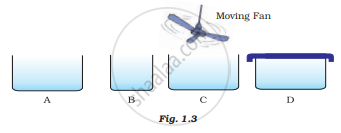
Conversion of solid to vapour is called sublimation. Name the term used to denote the conversion of vapour to solid.
Conversion of solid state to liquid state is called fusion; what is meant by latent heat of fusion?
NCERT Exemplar solutions for Science [English] Class 9 1 Matter In Our Surroundings Long Answer Questions [Page 11]
You are provided with a mixture of naphthalene and ammonium chloride by your teacher. Suggest an activity to separate them with well labelled diagram.
It is a hot summer day, Priyanshi and Ali are wearing cotton and nylon clothes respectively. Who do you think would be more comfortable and why?
You want to wear your favourite shirt to a party, but the problem is that it is still wet after a wash. What steps would you take to dry it faster?
Comment on the following statements:
Evaporation produces cooling.
Comment on the following statements:
Rate of evaporation of an aqueous solution decreases with increase in humidity.
Comment on the following statements:
Sponge though compressible is a solid.
Why does the temperature of a substance remain constant during its melting point or boiling point?
Solutions for 1: Matter In Our Surroundings
![NCERT Exemplar solutions for Science [English] Class 9 chapter 1 - Matter In Our Surroundings NCERT Exemplar solutions for Science [English] Class 9 chapter 1 - Matter In Our Surroundings - Shaalaa.com](/images/science-english-class-9_6:5f2b1b2038084cf381bfa42c826a928c.jpg)
NCERT Exemplar solutions for Science [English] Class 9 chapter 1 - Matter In Our Surroundings
Shaalaa.com has the CBSE Mathematics Science [English] Class 9 CBSE solutions in a manner that help students grasp basic concepts better and faster. The detailed, step-by-step solutions will help you understand the concepts better and clarify any confusion. NCERT Exemplar solutions for Mathematics Science [English] Class 9 CBSE 1 (Matter In Our Surroundings) include all questions with answers and detailed explanations. This will clear students' doubts about questions and improve their application skills while preparing for board exams.
Further, we at Shaalaa.com provide such solutions so students can prepare for written exams. NCERT Exemplar textbook solutions can be a core help for self-study and provide excellent self-help guidance for students.
Concepts covered in Science [English] Class 9 chapter 1 Matter In Our Surroundings are Heat and change of physical state, Matter (Substance), Characteristics of Particles (Molecules) of Matter, The Solid State, The Liquid State, The Gaseous State, Plasma, Concept of Melting (Fusion), Concept of Boiling (Vaporization), Concept of Evaporation, Bose-einstein Condensate, Concept of Sublimation, Concept of Freezing (Solidification), Concept of Condensation (Liquefaction), Concept of Desublimation (Deposition).
Using NCERT Exemplar Science [English] Class 9 solutions Matter In Our Surroundings exercise by students is an easy way to prepare for the exams, as they involve solutions arranged chapter-wise and also page-wise. The questions involved in NCERT Exemplar Solutions are essential questions that can be asked in the final exam. Maximum CBSE Science [English] Class 9 students prefer NCERT Exemplar Textbook Solutions to score more in exams.
Get the free view of Chapter 1, Matter In Our Surroundings Science [English] Class 9 additional questions for Mathematics Science [English] Class 9 CBSE, and you can use Shaalaa.com to keep it handy for your exam preparation.
